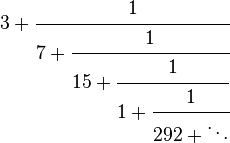| Author |
Message |
Keripo
Contributor

Joined: 26 Jul 2007

|
 Posted:
Mon Feb 18, 2008 10:22 pm Posted:
Mon Feb 18, 2008 10:22 pm |
  |
As the title hints, this podzilla2 module uses a cross-compiled pi-agm
binary to calculates digits of pi. It uses the terminal module to allow
for input.
Due to a bug in the terminal module, backspacing will not work (I would
link to a trac ticket if trac wasn't down - if you have the time to fix
it, a patch would be greatly welcomed). If you make an input mistake,
just exit and re-enter the window and re-input things carefully. Once
the calculations are done, pi-agm will exit and the calculated values
will be saved in a text file located where-ever your current working
directory is (e.g. mine saved to "/pi8k.txt").
Here's the readme:
| ReadMe from Keripo.txt wrote: |
Last updated: Feb 18, 2008
~Keripo
Calculates digits of pi via pi-agm. Uses the terminal module for input.
Saves output to working directory (most likely root "/pi##.txt").
Was able to calculate 8192 digits in 37 seconds (used "8k", "2", "-1").
pi-agm is written by Carey Bloodworth.
http://web.archive.org/web/20030803090725/http://www.bloodworth.org/
Source code downloaded from myownlittleworld.com
http://myownlittleworld.com/miscellaneous/computers/files/pi-programs/source/pi-agm.tgz
To compile pi-agm, extract the original source code, replace the
"${LD} ${LDFLAGS} ${OUT_FILE} .o ${MATH_LIBS}" line of your intended
target in src/Makefile with "${CC} ${LDFLAGS} -o ${OUT_FILE} .o ${MATH_LIBS}"
and compile with "make fft-hartley CC=arm-elf-gcc LDFLAGS=-elf2flt"
(you can replace fft-hartley with whichever type you want). This will give
an unoptimized pi-agm binary that you can run on iPodLinux. I may port this
as a proper podzilla2 module later when I have time. |
(Note that when I say "when I have time", it doesn't necessarily mean anytime soon ; P
Download:
http://ipodlinux.org/Image:Picalc-1.0.tar.gz
Knock yourselves out 
~Keripo |
_________________
Project ZeroSlackr
http://sourceforge.net/projects/zeroslackr/
Me = Keripo, Keripo Test Account = Me
010/001/111 |
|
  |
 |
zowki

Joined: 17 Sep 2006
Location: /mnt/zowki

|
 Posted:
Tue Mar 18, 2008 8:21 am Posted:
Tue Mar 18, 2008 8:21 am |
  |
Wouldnt it just be easier to make the ipod calculate 22 divide by 7 and tell it when to stop? |
_________________
My ipods:
iPod Nano 1G 2GB
iPod Video 5g 60GB |
|
    |
 |
joeyjwc
Moderator

Joined: 30 Oct 2005

|
 Posted:
Tue Mar 18, 2008 10:01 am Posted:
Tue Mar 18, 2008 10:01 am |
  |
| zowki wrote: |
| Wouldnt it just be easier to make the ipod calculate 22 divide by 7 and tell it when to stop? |
22/7 is not pi. It's an approximation of pi. |
_________________
JWC
http://jwcxz.com/
http://blog.jwcxz.com/ |
|
   |
 |
zowki

Joined: 17 Sep 2006
Location: /mnt/zowki

|
 Posted:
Tue Mar 18, 2008 12:04 pm Posted:
Tue Mar 18, 2008 12:04 pm |
  |
| joeyjwc wrote: |
| zowki wrote: |
| Wouldnt it just be easier to make the ipod calculate 22 divide by 7 and tell it when to stop? |
22/7 is not pi. It's an approximation of pi. |
Wow, I never knew that! I always thought it was! So what equation actually does calculate pi?
Edit: According to wikipedia:
| Quote: |
| it cannot be expressed as a fraction m/n, where m and n
are integers. Consequently its decimal representation never ends or
repeats. Beyond being irrational, it is a transcendental number, which
means that no finite sequence of algebraic operations on integers
(powers, roots, sums, etc.) could ever produce it. |
Its impossible to have an equation for it... So how can it be calculated to be more exact? |
_________________
My ipods:
iPod Nano 1G 2GB
iPod Video 5g 60GB |
|
    |
 |
Keripo Test Account
Contributor

Joined: 11 Apr 2006
Location: Ontario, Canada

|
 Posted:
Tue Mar 18, 2008 2:46 pm Posted:
Tue Mar 18, 2008 2:46 pm |
  |
Look at the pi-agm source code and you'll find various different
algorithms ; ) Hartley's FFT is the fastest in pi-agm but theres also
instructions on how to create your own algorithm/pi-agm build in the
source code (my build is the recommended fft-hartley target though you
can also build the other targets - haven't tried any other though and
all of them are optimized for Intels I think so performance may vary on
the iPod) |
_________________
Project ZeroSlackr
http://sourceforge.net/projects/zeroslackr/
http://ipodlinux.org/forums/viewtopic.php?t=29636 |
|
      |
 |
zowki

Joined: 17 Sep 2006
Location: /mnt/zowki

|
 Posted:
Tue Mar 18, 2008 2:52 pm Posted:
Tue Mar 18, 2008 2:52 pm |
  |
Looked at agm.c and this is what I found:
| Code: |
/*
** The AGM itself
**
** A[0]=1 B[0]=1/sqrt(2) Sum=1
**
** n=1..inf
** A[n] = (A[n-1] + B[n-1])/2
** B[n] = Sqrt(A[n-1]*B[n-1])
** C[n] = (A[n-1]-B[n-1])/2 or:
** C[n]^2 = A[n]^2 - B[n]^2 or:
** C[n]^2 = 4A[n+1]*C[n+1]
** Sum = Sum - C[n]^2*(2^(n+1))
** PI[n] = 4A[n+1]^2 / Sum
**
** However, it's not implemented that way. We can save a full
** sized multiplication (with two numbers) by rearranging it,
** and keeping the squares of the A and B. Also, we can do the
** first pass a little differently since A and A^2 will both be 1.
**
** A[0]=1 A[0]^2=1
** B[0]=1/sqrt(2) B[0]^2=0.5
**
** First pass:
**
** A[1] = (A[0] + B[0])/2
** B[1]^2 = A[0]*B[0] ; Since A[0]==1, B[1]^2=B[0]
** C[1]^2 = ((A[0]^2+B[0]^2)/2-B[1]^2)/2
**
** Remainging passes:
**
** C[n] = (A[n-1]-B[n-1])/2; C[n] is actually temp usage of C[n]^2
** A[n] = A[n-1] - C[n]
** C[n]^2 = C[n]*C[n]
** B[n]^2 = (A[n-1]^2+B[n-1]^2-4C[n]^2)/2
**
** Then the rest of the formula is done the same:
**
** A[n]^2 = C[n]^2 + B[n]^2
** B[n] = sqrt(B[n]^2)
** Sum = Sum - C[n]^2*(2^(n+1))
**
** It is an unusual arrangment, but they are all derived directly
** from the standard AGM formulas as given by Salamin.
**
*/ |
That is really confusing! I'm only in grade 8 maths! |
_________________
My ipods:
iPod Nano 1G 2GB
iPod Video 5g 60GB |
|
    |
 |
Keripo Test Account
Contributor

Joined: 11 Apr 2006
Location: Ontario, Canada

|
 Posted:
Tue Mar 18, 2008 2:56 pm Posted:
Tue Mar 18, 2008 2:56 pm |
  |
Read more books then. Or, you know, google more 
I myself haven't even looked at any of the algorithms and doubt I'd be
able to fully understand them myself. And theres really no need to other
than out of curiousity. If you're really all that curious, try asking
your math teacher (though s/he probably won't have an answer). No need
to post your every question here ; P |
_________________
Project ZeroSlackr
http://sourceforge.net/projects/zeroslackr/
http://ipodlinux.org/forums/viewtopic.php?t=29636 |
|
      |
 |
megabyte

Joined: 02 Nov 2005
Location: /dev/null

|
 Posted:
Sun Mar 23, 2008 6:46 pm Posted:
Sun Mar 23, 2008 6:46 pm |
  |
Wasn't there a chain fraction to calculate it? |
_________________
The 2.5 booter - Gentoo from Stage3 + Ubuntu 7.10 + Mac OS X 10.5.1. |
|
      |
 |
zowki

Joined: 17 Sep 2006
Location: /mnt/zowki

|
 Posted:
Mon Mar 24, 2008 3:25 am Posted:
Mon Mar 24, 2008 3:25 am |
  |
| megabyte wrote: |
| Wasn't there a chain fraction to calculate it? |
According to wikipedia Pi can not be represented in a fraction as it would still be continuous.
Like this:

Or the Gregory-Leibniz series:

But it seems as if wikipedia is contradicting itself because I looked
under Computing Pi and I found it actually can be written as a formula.
Here are two famous ones:

 |
_________________
My ipods:
iPod Nano 1G 2GB
iPod Video 5g 60GB |
|
    |
 |
joeyjwc
Moderator

Joined: 30 Oct 2005

|
 Posted:
Mon Mar 24, 2008 5:06 am Posted:
Mon Mar 24, 2008 5:06 am |
  |
This makes much more sense if you have studied series. @zowki:
Wikipedia is not contradicting itself. The "formula" you found is just
an infinite series where you sum each term. That's what that big sigma
means. |
_________________
JWC
http://jwcxz.com/
http://blog.jwcxz.com/ |
|
   |
 |
megabyte

Joined: 02 Nov 2005
Location: /dev/null

|
 Posted:
Mon Mar 24, 2008 11:36 pm Posted:
Mon Mar 24, 2008 11:36 pm |
  |
(for those less mathematical: a sigma = a sum of iterations. Under it
you state the iteration variable, in this case K, and what value does it
start with, in this case 0. Over the sigma is the maximum of
iterations, in this case infinity. After the sigma you will find what to
do with K in each iteration, thus what to sum up) |
_________________
The 2.5 booter - Gentoo from Stage3 + Ubuntu 7.10 + Mac OS X 10.5.1. |
|
      |
 |
|
|
